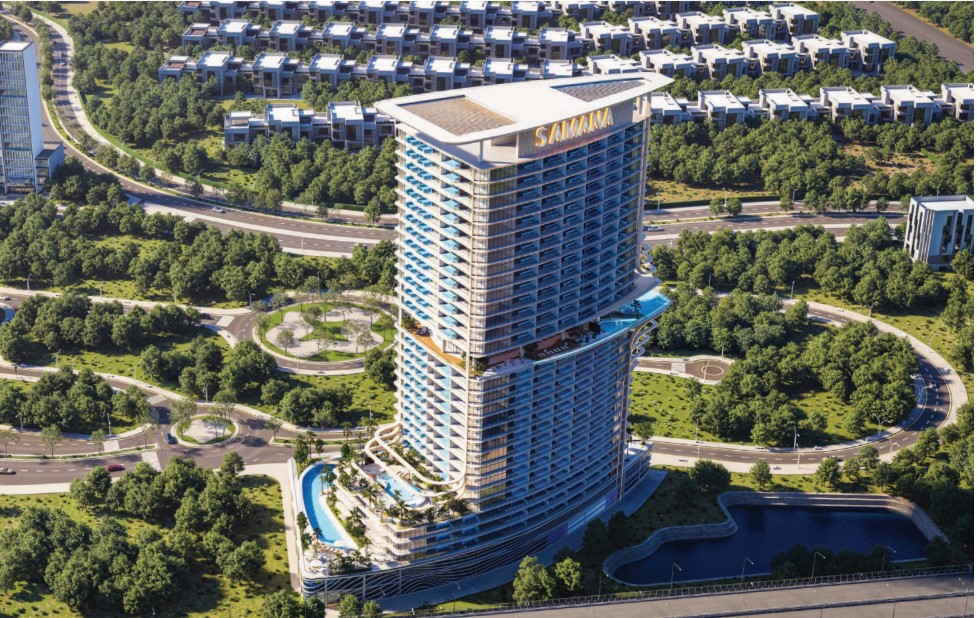Dubai’s real estate market has long been synonymous with grandeur, ambition, and architectural marvels. But as 2025 unfolds, the emirate is redefining itself not just with bold structures, but through meaningful innovation—integrating sustainability, tech, experience, and community into every brick and beam. Here’s how architectural innovation is transforming Dubai’s real estate.
1. Eco-Conscious Design & Biophilic Architecture
Dubai’s urban core is evolving into a green haven. Developers are increasingly integrating biophilic design—think lush terraces, vertical gardens, and indoor water features. Projects like District One in MBR City now feature retractable glass roofs that blur the line between indoor and outdoor living .
The push for sustainability is more than aesthetic. Solar panels, grey-water recycling, and energy-efficient façades are now standard across projects like Uptown Tower and Binghatti Azure, aligned with Dubai’s Net Zero 2050 and green building mandates . Older icons, such as the Museum of the Future, earned LEED Platinum certification with its futuristic design and Arabic calligraphy façades that symbolize innovation itself .
2. PropTech & Smart Building Integration
Dubai is leaps ahead in embedded technology. Internet of Things-enabled homes can manage lighting, climate, and security via apps; AI systems optimize energy use and predictive maintenance; and even high-end buildings in areas like Business Bay feature smart air-quality monitoring systems .
Blockchain is revolutionizing transactions. The Dubai Land Department’s pilot real estate tokenization program uses digital tokens and fractional ownership, drawing crowds toward secure, liquid, and transparent investment models . Virtual and augmented reality are reshaping property viewings—led by Dubai Land Department’s VR platform—which has helped facilitate over AED 1 billion in sales .
3. Sky-High Living & Tomorrow’s Landmarks
Dubai continues its tradition of architectural record-breaking. Among the most notable:
- One Za’abeel: Two towers connected by a 230 m-long cantilever—an engineering marvel recognized by Guinness World Records .
- Burj Binghatti Jacob & Co Residences: Soaring at 557 m over Business Bay, projected as the world’s tallest residential building .
- Burj Azizi (formerly Entisar Tower): A 725 m skyscraper under construction on Sheikh Zayed Road, potentially the world’s second tallest upon completion .
- Dubai Creek Tower: Santiago Calatrava’s design for a 828 m+ minaret-inspired marvel, set to redefine the skyline at Creek Harbour .
Hospitality architecture also dazzles: Ciel Tower—Dubai Marina’s 1,200 ft tower—is set to be the world’s tallest hotel (1,000 rooms + sky-high infinity pool) by end-2025 . The “Regent Residences” twin towers in Marasi Marina will each feature private balcony pools and a sky-lido between them—an exclusive residential marvel .
4. Lifestyle-Focused & Experiential Masterplans
No longer is real estate just about walls and floors—it’s about crafting lifestyles. Mixed-use communities combining residences, workspace, retail, and wellness attract millennials and expatriates seeking convenience and belonging .
Developments like Dubai Creek Harbour’s skyline city, Marsa Al Arab’s island resort complex, and more intimate enclaves such as Mirdif Hills and Bluewaters are designed to deliver 360° experiences—live, work, play—in one curated space .
5. Ultra-Luxury with Bespoke Innovation
For high-net-worth individuals, Dubai continues raising the bar. Sky-high penthouses, private pools, and brand-affiliated residences speak directly to elite tastes.
- The Burj Khalifa Sky Palace is the highest residential unit globally—21,000 sq ft with private elevator and pool—on the 107th/108th floors, priced at US $49 million .
- Regent Residences: Each apartment starts at 6,500 sq ft, features private balcony pools, and is praised for its nature-inspired, elegantly shaded façades .
Luxury buyers increasingly prioritize architectural pedigree, privacy, experiences, and wellness, signaling a shift toward curated living as the ultimate status symbol .
6. Policy, Investment & Economic Context
Dubai’s real estate innovation emerges from a robust ecosystem bolstered by steady GDP growth (~6.2% projected through 2025), initiatives like the Golden Visa, and regulatory incentives .
Rental demand and capital values continue to rise, with expected growth of 8–18% and surging investor appetite across segments—from co-living units to ultra-luxury towers .
In Summary
Dubai’s real estate today is an architecture of the future—a synergy of sustainability, smart tech, visionary design, opulent living, and immersive community experience. Its skyline doesn’t just reach upward—it pushes boundaries in how we define next-gen urban life.
Whether you’re an investor, resident, or architecture enthusiast, Dubai’s 2025 market offers a landscape rich with innovation and opportunity—proof that here, the future isn’t just envisioned; it’s built.

